
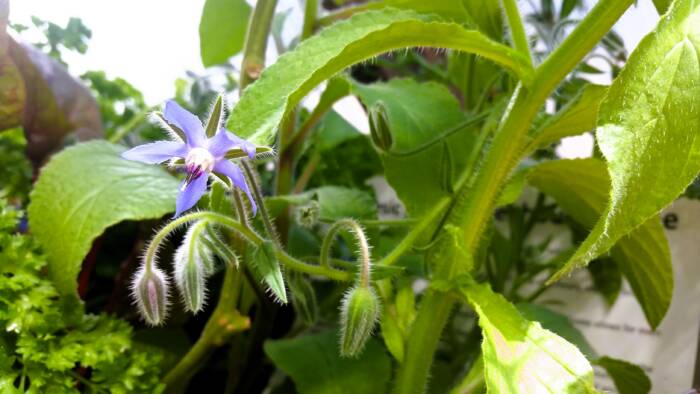
Genus: Borago officinalis Common Name: Borage, starflower Type: Annual, herb Height: 1-3 feet tall Width: 9-18 inches wide Zone: 2-11
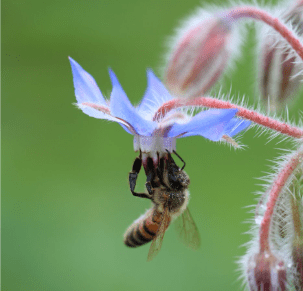
Growing Borage in a Greenhouse
Borage, an annual herb loved by bees, serves as an excellent pollinator attractor for your greenhouse. Cultivating borage within a Growing Dome greenhouse enriches it with numerous benefits, from its aesthetic appeal to its effectiveness as a companion plant. This remarkable addition not only enhances the beauty of your greenhouse but also has the unique ability to reseed itself, ensuring a continuous supply year after year.
Best Location to Plant Borage
Borage will grow well in full sun or partial shade. Choose full sun for maximum flower production. Borage handles a wide temperature range, but is not frost tolerant. Choose the location for borage in your greenhouse to incorporate it as a companion plant for your other crops. (Read more about companion planting below.)
How to Plant Borage
Below are some tips for planting borage.
- The soil should be well-draining and rich in nutrients with a soil pH between 6.0 and 7.0.
- Pro Tip: Perform a soil test in early spring.
- Plant seeds a half-inch deep in well-draining soil. Plant in groups of 3-4 seeds. If you are going to plant multiple plants be sure to allow 12-18” spacing.
- Pro Tip: The length of your index fingernail = ½”.
- Water the seeds consistently to give your borage a good start.
- Plant borage in full sun for maximum flower production. Six hours or more per day is best. You can plant borage in partial shade.

Borage Companion Plants
Companion plants are the superheroes in your Growing Dome! They are protecting your crops and improving the soil. Borage is often chosen as a companion to help other plants. It has its own wonderful uses and is a lovely addition to your dome.
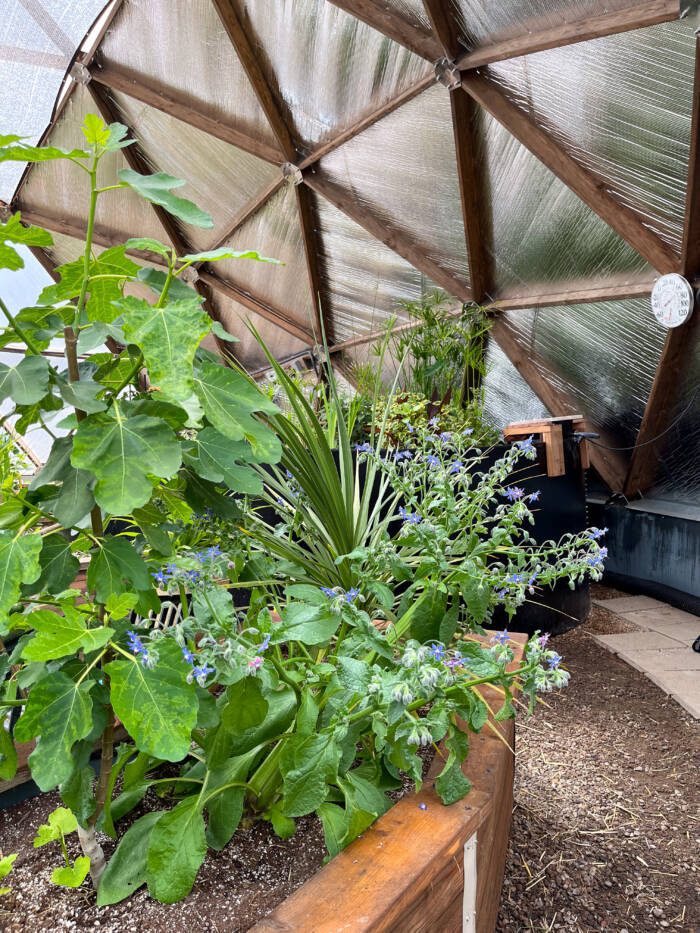
Plant a healthy garden with borage and these companions:
- Beans, Cucumbers and Peas – Choose climbing varieties and plant borage around the trellises. Borage will bring on the pollinators and deter pests.
- Cabbage – Borage is cabbage’s Batman and Robin against cabbage worms. Holy cabbage worm, Batman! KAPOW! BONK! WHACK!
- Squash – Allow room for growth between borage and squash. Both plants can be susceptible to powdery mildew.
- Strawberries – Borage does dual duty with your delicious strawberries by repelling pests and attracting beneficial insects.
- Tomatoes – Plant borage with tomatoes to help repel hornworms and cabbage worms. Hooray for borage!
Borage doesn’t like to hang out with these plants: potatoes, fennel, black walnut. For harmony in your garden, don’t plant them together!
Caring for Borage Plants
Borage is an easy keeper and prefers full sun. Give it a minimun of 6 hours of sunlight per day to keep it happy.
As far as watering, borage does not like to be waterlogged. Consistent watering is recommended after the seeds have been planted. Allowing the soil to dry between watering after your plant matures is fine.
Pruning Borage Flowers
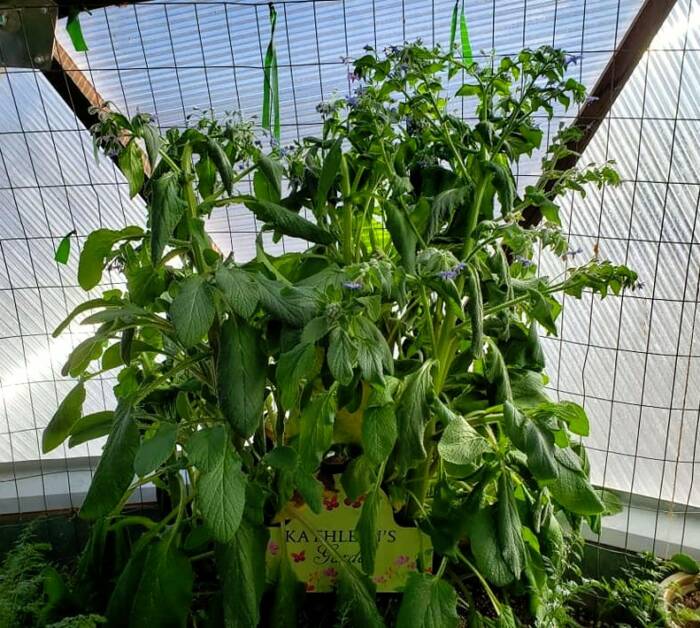
Harvest borage flowers and leaves throughout the growing season. Deadheading borage will help encourage the plant to continue blooming. To help your borage grow new leaves for a late season harvest, trim borage to half its size in the middle of summer.
Borage sometimes grows a little too tall to support itself. The Royal Horticultural Society says: “No pruning is required for the borage. Plants generally don’t need staking, but sometimes they can flop over and so will occasionally need a support to prevent a plant squashing it’s neighbors in the border.” No squashing your neighbors, let’s be friendly companions in the garden!
Managing Common Borage Pests
Companion planting: The first line of defense! Companion plants deter pests and attract beneficial insects and pollinators. They can also help improve the soil.
Borage rarely has issues with pests. Towards the end of summer powdery mildew can occur. Water the soil rather than the leaves to avoid powdery mildew.
Harvesting Borage
Harvest borage flowers once the plant blooms and continue harvesting through the season. Borage is mature about two months after planting and the flowers have a cucumber like taste*.
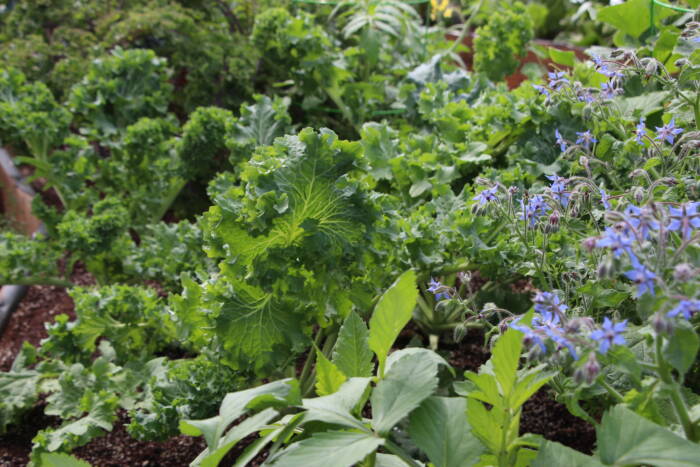
Borage History and Trivia
Originally native to the Mediterranean area, borage is now found naturally throughout Europe. The scientific name of borage means “father of roughness.” This is in reference to the rough texture of the leaves.
Some historians and botanists believe that borage was the “Nepenthe” Homer wrote about in book four of his Odyssey. Nepenthe translates to “that which chases away sorrow”. Drinking alcohol steeped with borage may cause the drinker to enter a state of forgetfulness.
Borage or starwort was known as one of the four “cordial flowers most esteemed for cheering the spirits.”
Some interesting tidbits about borage:
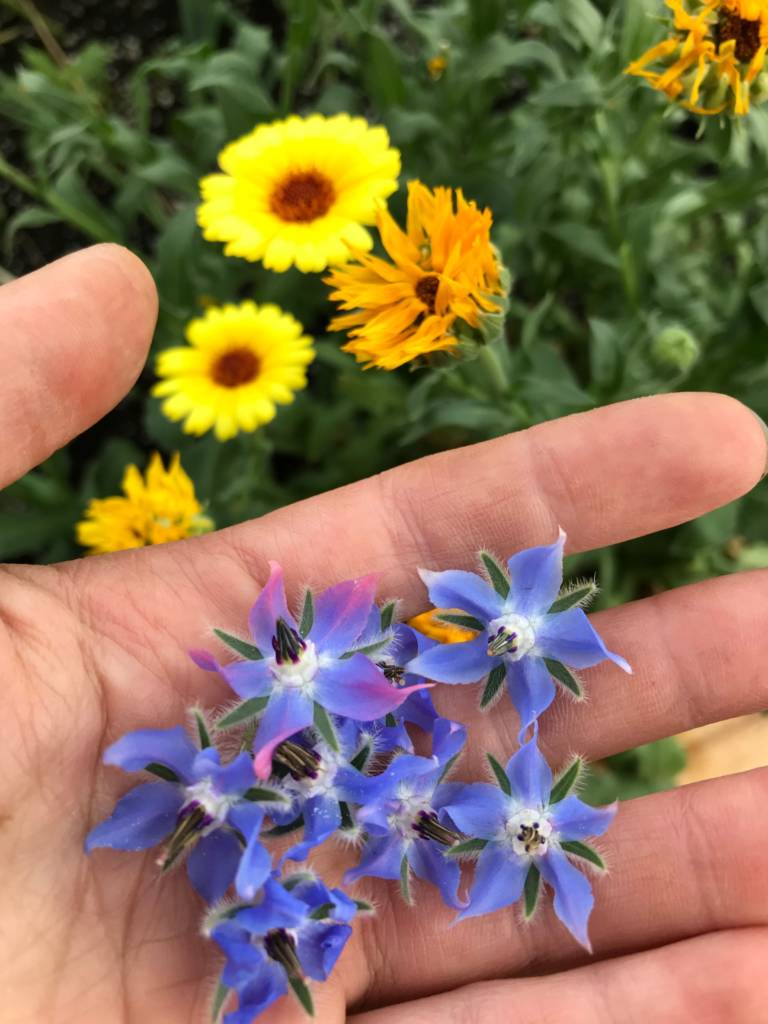
- Borage flowers can be candied to top desserts!
- If you have room in your freezer add fresh borage flowers to some ice cube trays and freeze them. You can serve beautiful cocktails at your gatherings!
- Beautiful borage is a “star” in the cosmetic industry. Companies extract borage oil from seeds to create products to the nourish the skin.
- Borage flowers are a favorite with textile artists and crafters. It creates beautiful hues of blue, purple, pink and green dye.
- Folklore suggests that in the Middle Ages a woman might slip borage flowers into her suitor’s wine to give him courage to propose. ProTip: Add it to your home grown salad and give it to your suitor! 😉
- Borage or borrage, may be derived from the Celtic word borrach. Borrach translates to courage and was a sacred plant to the Druids. Warriors were given wine that had been steeped with borage flowers.
- Borage has many names! Here are some of the English folk names for borage: bee plant, bee bush, bee bread, ox tongue, talewort starflower, cool tankard (what?), herb of gladness😊, borak, euphrosinum and common bugloss.
Health Benefits of Borage
In Roman times Pliny the Elder considered borage had anti-depressant qualities, which fits with the belief that it brought courage and comfort to the heart. Famous herbalist John Gerard applied the “flowers in salads to exhilarate and make the mind glad, to the comfort of the heart and driving away of sorrow.”
In traditional medicine borage is used for a variety of ailments. Dry leaves for herbs or to use in tea. Borage flowers are used as a garnish in salads and other dishes. Add it to beverages for a beautiful garnish. Borage is high in omega-6 fatty acids.

Borage contains small amounts of pyrrolizidine alkaloids. Use borage sparingly as it can cause an upset stomach or other more serious health issues. Try this delicious recipe: Borage tzatziki
*NOTE: Borage does contain toxins in small concentrations, which can lead to digestive upset and other issues if eaten daily and/or in large quantities. Those with liver issues, pregnant or breastfeeding women and those with seizures should avoid borage. Borage can be toxic to pets.
Feeling blue? Plant some borage in your dome! Its beautiful flowers will make you happy and your bees will love you for growing one of their favorite flowers!
